
Entomology is the scientific study of insects, a branch of zoology. In the past the term insect was less specific, and historically the definition of entomology would also include the study of animals in other arthropod groups, such as arachnids, myriapods, and crustaceans. This wider meaning may still be encountered in informal use.

Thomas Say was an American entomologist, conchologist, and herpetologist. His studies of insects and shells, numerous contributions to scientific journals, and scientific expeditions to Florida, Georgia, the Rocky Mountains, Mexico, and elsewhere made him an internationally known naturalist. Say has been called the father of American descriptive entomology and American conchology. He served as librarian for the Academy of Natural Sciences of Philadelphia, curator at the American Philosophical Society, and professor of natural history at the University of Pennsylvania.

Zyzzyx is a monospecific genus of sand wasp, containing a brightly coloured, medium-sized species, Zyzzyx chilensis. It is primarily a predator on flies, but has been observed to consume skippers. "Zyzzyx" is a replacement name proposed in 1937 by V. S. L. Pate for Therapon, originally described by J. Parker in 1929.
Michael S. Engel, FLS, FRES is an American paleontologist and entomologist, notable for contributions to insect evolutionary biology and classification. In connection with his studies he has undertaken field expeditions in Central Asia, Asia Minor, the Levant, Arabia, eastern Africa, the high Arctic, and South and North America, and has published more than 925 papers in scientific journals and over 1000 new living and fossil species. Some of Engel's research images were included in exhibitions on the aesthetic value of scientific imagery.
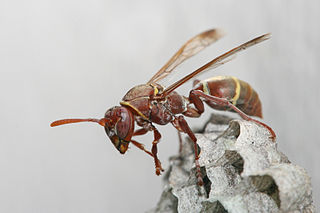
The Polistinae is a subfamily of eusocial wasps belonging to the family Vespidae. They are closely related to the wasps and true hornets of the subfamily Vespinae, containing four tribes. With about 1,100 species total, it is the second-most diverse subfamily within the Vespidae, and while most species are tropical or subtropical, they include some of the most frequently encountered large wasps in temperate regions.

Ant mimicry or myrmecomorphy is mimicry of ants by other organisms; it has evolved over 70 times. Ants are abundant all over the world, and potential predators that rely on vision to identify their prey, such as birds and wasps, normally avoid them, because they are either unpalatable or aggressive. Some arthropods mimic ants to escape predation, while some predators of ants, especially spiders, mimic them anatomically and behaviourally in aggressive mimicry. Ant mimicry has existed almost as long as ants themselves; the earliest ant mimics in the fossil record appear in the mid-Cretaceous alongside the earliest ants.

Howard Ensign Evans was an American entomologist who was a specialist on wasps. He was also the author of several popular works on entomology including Life on a Little-known Planet (1978), The Pleasures of Entomology (1985) and Wasp Farm (1963).

Agelaia is a genus of Neotropical social wasps, with species from Mexico to northern Argentina. Fifteen of the 31 described species are found in Brazil. These species are swarm founders that nest in cavities. The nest generally is without an envelope.

Leschenaultia is a genus of flies in the family Tachinidae.
Cornelius Becker Philip (1900–1987) was an American entomologist, noted for assigning comedic names to species he described.
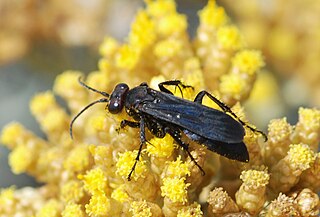
Agenioideus is a genus of spider wasps from the subfamily Pompilinae; the genus occurs in Europe, where 21 species are recorded, eastwards to Japan, in North America, South America, and Australia.

Panopinae is a subfamily of small-headed flies (Acroceridae). Their larvae are endoparasites of spiders in the infraorder Mygalomorphae.

The Central American paper wasp is a nocturnal eusocial wasp. It is famous for its swarm based emigration behavior, and is native to the lowlands of Central and northern South America. This species has developed special night vision adaptations to facilitate their night-time swarming and foraging behavior and has important medicinal properties for the Pankararú people of Brazil.
Apoica flavissima is a paper wasp found primarily in South America. The species is distinguishable by its light coloring, unique single comb nests, and nocturnal nature. A notable feature of this species is the size dimorphism between queens and workers. Unlike most Vespidae wasps, Apocia flavissima queens are smaller than their worker counterparts which results in unique intraspecies relationships.
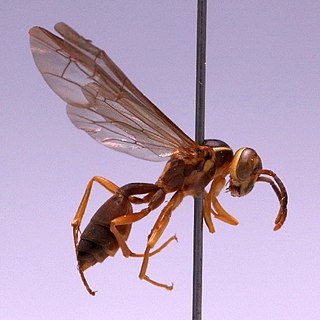
Angiopolybia pallens is a species of social wasp predominantly found in South America. The wasp is generally seen in Brazilian rainforests. This species was discovered by Lepeletier in 1836. It typically feeds on nectar and carrion. In fact much of its feeding behavior and impact on humans is centered on feeding on animal carcasses. The wasp species displays a caste differentiation that can be seen by difference in ovarian development. Additionally they have a unique colony establishment procedure. It begins with a few individuals from the nest leaving to find a good site and then the rest of the colony follows using specific communication signals that are further discussed in this article.
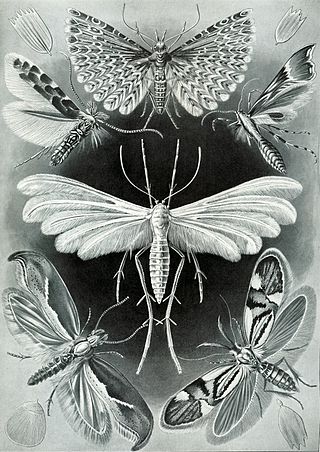
Annette Frances Braun was an American entomologist and leading authority on microlepidoptera, a grouping of mostly small and nocturnal moths. Her special interest was leaf miners: moths whose larvae live and feed from within a leaf.
Ireangelus is a genus of kleptoparasitic spider wasps from the sub-family Ceropalinae of the family Pompilidae. The genus has a pan tropical distribution, being known from Oriental, Neotropical, Australian, eastern Palearctic, and Madagascan Zoogeographic regions being best represented in the Neotropics. Irenangelus is closely related to the more widespread genus Ceropales, the two genera forming a monophyletic subfamily, Ceropalinae within the Pompilidae. This is regarded as the most basal grouping of the Pompilidae but this view is problematic because of the kleptoparasitic life history of the Ceropalines, it is now considered that they Ceropalines and other pompilids evolved from a common ectoparasitoid ancestor.

Ephydrinae is a subfamily of shore flies in the family Ephydridae.
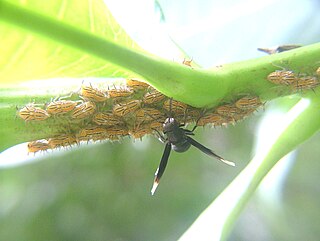
Parachartergus is a genus of epiponine social wasps belonging to the subfamily Polistinae. Species include:

Howard Radclyffe Roberts Jr. was an American entomologist known for his work on grasshoppers. His 1941 University of Pennsylvania Ph.D. dissertation was an early work highlighting the role phallic structures could play in grasshopper taxonomy. While serving in World War II, he and Edward Shearman Ross cowrote The Mosquito Atlas, used by the armed forces to identify malaria-transmitting mosquitos. Roberts worked for the Academy of Natural Sciences of Philadelphia (ANSP), serving as its managing director from 1947 to 1972. He described dozens of grasshopper species from North and South America, and also is the eponym of several taxa named in his honor.
















